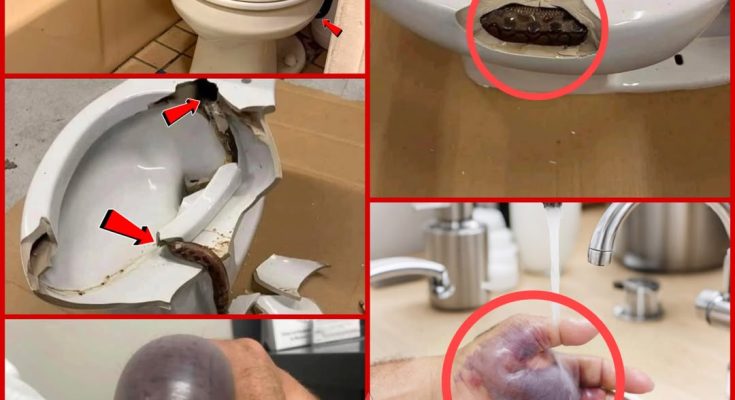🐍 Snake Bites from Toilets: A Growing Danger in Unexpected Places
For most of us, the bathroom is a place of comfort and solitude—a quiet spot where we begin and end our day. But what if the very place you expect to be safest is hiding a nightmare?
Around the world, a disturbing trend is emerging: people are being bitten by snakes while using the toilet.
Yes, you read that correctly. These incidents, though still rare, are terrifyingly real. From Thailand to South Africa, the United States to Australia, snakes are finding their way into our homes—and straight into the last place we expect: the toilet bowl.
😨 The Real-Life Horror Stories
Thailand: It was a quiet night in suburban Bangkok. Somchai, a 45-year-old office worker, got up to use the bathroom, half-asleep. As he sat down, a sharp, unbearable pain shot through his body. He screamed in agony. A 12-foot reticulated python, coiled inside the toilet, had bitten him directly on the testicles.
It took emergency responders over 30 minutes to remove the massive snake, and Somchai needed multiple stitches and surgery to repair the damage. The trauma, however, lingered far longer. “Now, I always check the toilet,” he said in a later interview. “I can’t use one without turning on all the lights first.”
South Africa: In the wilderness of Limpopo, a 47-year-old Dutch tourist was using an outdoor pit toilet at a lodge when he felt a sharp sting. He looked down to discover a Cape cobra, one of the deadliest snakes in Africa, had latched onto his genitalia.
He was rushed to the hospital by helicopter and required intensive surgery and antivenom to survive. Doctors described his injury as “severe and delicate.” Though he made a full physical recovery, the mental scars may never heal.
Texas, USA: In a quiet suburban neighborhood, a woman was using her home bathroom when she felt a sudden bite on her backside. A non-venomous rat snake had climbed up through the home’s sewer system. Although the snake wasn’t venomous, the shock and panic were overwhelming.
Australia: In Queensland, a woman sat down to use the toilet and was bitten on the thigh by a carpet python hiding in the bowl. She screamed, jumped, and called for help. Fortunately, the python was non-venomous, but the experience left her shaken. “I thought I was dreaming. It was something out of a horror movie,” she told local news.
🐍 How Do Snakes Get Into Toilets?
This terrifying phenomenon raises an important question: How do snakes end up in toilets?
Experts explain that snakes are excellent climbers and swimmers. During hot or rainy seasons—especially in tropical and subtropical regions—snakes seek out cool, damp places to hide. Sewer systems, plumbing lines, and open vents provide perfect entry points into homes.
Once inside, snakes can:
-
Slither up through pipes connected to toilets
-
Enter through cracks in bathroom floors or walls
-
Drop down through open roof vents
-
Hide in bathroom corners, under sinks, or behind toilets
A herpetologist in Australia said, “People assume it’s impossible for snakes to come up through a toilet. But the truth is, plumbing systems provide an unintentional highway for reptiles looking for shelter or prey.”
In rural areas or older homes with damaged or exposed plumbing, the risk increases dramatically.
⚠️ What Makes Bathrooms Vulnerable?
Several factors make bathrooms especially attractive to snakes:
-
Moisture: Snakes are drawn to damp, humid environments.
-
Darkness: Bathrooms often have dim lighting or are left in the dark overnight.
-
Access: Roof vents, uncovered drains, cracked pipes, or poorly sealed connections give snakes a way in.
-
Rodents and frogs: Bathrooms that attract pests can also attract snakes looking for a meal.
🛡️ How to Protect Yourself
Though the chances of encountering a snake in your toilet are still low, it’s wise to take precautions—especially if you live in snake-prone areas.
Here’s how to stay safe:
-
Always look before you sit: A quick glance can save you from serious injury.
-
Close toilet lids: Especially overnight, to prevent any unexpected visitors from surfacing.
-
Seal cracks and gaps: Use caulk or sealant around baseboards, drains, and pipes.
-
Install screens on vents and drains: Mesh covers on sewer vents and roof openings can block snake entry.
-
Keep bathrooms clean and dry: Reduce standing water and keep the area clutter-free.
-
Use motion-activated lights: In outdoor or poorly lit bathrooms, lights can deter both snakes and their prey.
-
Call professionals: If you spot a snake, do not attempt to handle it. Call wildlife or pest control immediately.
🧠 Beyond the Bite: The Psychological Impact
Survivors of these incidents often report long-lasting fear and anxiety. Some suffer toilet-related PTSD, developing intense fear or hesitation before using the bathroom.
In Thailand, mental health counselors were brought in to help Somchai overcome his trauma. “The pain fades,” he said. “But the memory? That stays with you every time you sit down.”
💬 Final Thoughts
Snake bites from toilets might sound like something from a movie, but the reports are real—and rising. As urban areas continue to expand into wildlife habitats, and climate conditions change, human-snake encounters are becoming more frequent.
While we can’t always control nature, we can take steps to protect ourselves from its more surprising dangers.
So next time you walk into the bathroom—especially at night—remember: just because it’s rare doesn’t mean it can’t happen.
Take a look before you sit. It might just save your life.





